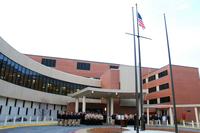Food stamp usage at military commissaries plummeted over the first quarter of fiscal 2014, the first such drop since before the great recession.
The number of transactions made with food stamps at the military commissary dropped 19 percent over the first quarter of fiscal 2014 compared to the first quarter of 2013. Previously, the number had steadily climbed, rising about 66 percent between 2009 and 2013.
The reduction corresponds with a much lower drop nationwide over the same period -- about 5.5 percent. Officials with the Supplemental Nutrition Assistance Program, as the food stamp program is now known, attribute the decrease to users having fewer funds thanks to the expiration of a 2009 stimulus law that hit Nov. 1.
"Military commissaries have the greatest percentage decrease among all store types," said Amanda Browne, a spokesperson for the U.S. Department of Agriculture, which administers the program. "The decline in redemptions overall could be attributed to the reduction in benefits when the American Recovery and Reinvestment Act benefits sunset in November."
That act's expiration reduced the monthly SNAP amount available for a family of three by about $29 and $36 for a family of four.
The drop in first quarter transactions may not correspond to a drop in users, since officials are tracking the number of transactions, not the number of people registered.
Available data showing how many active duty military users are registered for SNAP lags by several years. The most recent information, for fiscal year 2012, shows only 2,000 active duty military members used SNAP that year – down from 5,000 in 2011.
Active duty service members aren't the only shoppers using food stamps at the commissary. The bulk of SNAP transactions are likely being made by non active duty shoppers such as reservists, members of the National Guard and retirees, who are all eligible to shop at the commissary and may be using food stamps there. However, neither the Defense Commissary Agency (DeCA) nor the USDA tracks those types of users.
But fewer food stamps dollars available has not necessarily translated into hungry military families. Operation Homefront, a charity which regularly provides food to military families in crises, also saw a drop in requests for food assistance over the first quarter of 2014 when compared to the same quarter in 2013.
"My case workers tell me that this is actually probably significant because usually that time of year we would expect to see an increase," said Aaron Taylor, a spokesperson for Operation Homefront.
Over the first quarter of 2013 Operation Homefront received 1,415 food assistance requests. The number dropped to 1,334 over the first quarter of 2014.
Pentagon officials say so few active duty users qualify for food stamps because, in general, military pay corresponds with the size of a typical family in that pay grade. Those who do qualify for food stamps, they said, likely have larger than average families for that pay grade.
Military spouse Heidi Stewart is part of one such family. For their family of eight, she and her husband, an Army E-5, receive about $250 monthly in food stamps from the state of Texas where they are currently stationed at Fort Bliss. That's down from the about $650 they received monthly while stationed at Joint Base Lewis-McChord in Washington State. They also use the Women and Infants Children program, an additional subsidy for families with children under five-years-old.
"It helps offset the cost to feed our family – we're able to better provide for our children, live in a better area for family," she said. "I have no idea where we would be [without food stamps]. I would have to say we'd be relying on food pantries."
If Stewart's husband was to be promoted, their family may no longer qualify for benefits because their pay would be too high, she said.
"Military members normally ‘promote out' of the need for additional subsistence benefits, due to the corresponding raises in basic pay and other allowances as one moves to a higher pay grade," said Navy Lt. Cmdr. Nate Christensen, a DoD spokesperson.
In 2013 an Army E-2 with fewer than two years of service and no dependents earned on average about $41,749, figuring in base pay, housing and food allowances, and pays no taxes on the allowances, Christensen said.
The requirements for qualifying for food stamps vary state to state, sometimes drastically. Each state also has its own rules about what income and assets can be counted when determining whether or not a family qualifies. For example, some states count basic allowance for housing payments but not the value of your home if you live on-base. Others take both into account.
Additionally, the Defense Department has its own food assistance payout program which some military families choose to use instead. That payout, known as the Family Subsistence Supplemental Allowance (FSSA), is designed to mirror the amount a military family would likely receive in food stamp assistance.
Instead of being issued in a card that must be used to purchase groceries, however, the income is added to the monthly pay as a basic allowance for subsistence plus-up. It also allows military families stationed overseas, who are not eligible for SNAP, to receive assistance.
In calendar year 2012 only 421 military families received the FSSA benefit. That number may be so low because few families know about the benefit.
Military officials declined to speculate on why the commissaries would see such a large drop in food stamp transactions compared to all other SNAP accepting grocers in the nation.
"Ultimately, SNAP is designed to expand and contract with current economic conditions and assist those who are trying to put food on the table for their families," USDA officials said. "As we continue to create jobs and grow the economy, we will see this program shrink."
-- Amy Bushatz can be reached at amy.bushatz@monster.com


























